Has this happened to you? The sales department wins a job for process engineering, die design, tool build, and stamping production. Upon review of the bid package, you note the inclusion of a “quoted blank.” Immediately that blank has you beside yourself with frustration. The blank is hardly large enough to cover the blank holder that you recognize the part will need. If this situation is completely unknown to you, that’s rare and you are lucky.
Minimum blank size calculations are most often generated using a variety of commercially available programs (in the spirit of full disclosure: we sell one). These tools use what is known as the inverse one-step finite element analysis (FEA) method to predict the initial blank requirements of the analyzed geometry. Using a one-step code, one need only import the CAD shape of the part and define the material grade and thickness to compute the relative feasibility of the geometry and initial material or blank shape.

2-D section through initial part shape and inverse one-step estimated blank
The FEA code then computes the deformation of the original part shape being flattened to the initial flat blank shape. While the code computes, it determines how much stretching and compression happens to the finite elements within the mesh of the part, based on the material model supplied. This may seem pointless, as our business it to take flat sheet then add the shape, not flatten the finished part. The OneStep solver then inverts the computed strains and uses that information to the strain likely to occur when starting with a flat blank and in a single step forming the finished shape.

Sheet metal part and minimum blank prediction
The assumption is credible as long as one can assume that the majority of the forming happens in one step—from flat to complete part—and that the material in the part is the only material needed. This may be the case for some progressive dies and “crash-form” parts with fully developed blanks; however, if the part being quoted requires any drawing or stretching of the sheet metal, the blank may end up significantly larger than a simple OneStep predicted minimum blank.
For many parts, additional material beyond the part’s defined edge is required to restrict and control metal movement during forming. This is to prevent the formation of wrinkles and assure a minimum amount of stretching, often needed to permanently deform or plastically strain the sheet metal. This additional material would not be computed if one started the OneStep with only the blank shape. This is where many automatic minimum blank shape protocols go wrong.

Minimum blanks based on part shape only lack necessary material to produce quality parts
If a one-step is run on only the shape of the part, your computation result will be the minimum material required to define the part shape. It will not necessarily be the amount of material required by the tool to produce the part.
Improving the one-step minimum blank computation
You can improve the prediction of the minimum blank if you provide not only the geometry of the part shape but the potential geometry beyond the part boundary or edge. This additional geometry, or addendum, provides the additional area for the tool to grab onto and stretch the sheet during forming.

Proposed binder and addendum for draw, with secondary formed flanges developed for trimming
Providing that additional geometry is required if we want to predict the blank shape necessary to fit the tools. However, in order to predict that blank, the user has to define that geometry. That may require CAD or some other geometry modeling. Developing the 3-D geometry representing a plausible addendum is a significant part of the engineering work that this blank quote is meant to win. Certainly, if engineers were to completely engineer the 3-D tooling development or strip layout, they would know exactly what blank is needed, but that amount of work-at-risk (the work that is done in the hope of eventual payment) may not be justified. While the additional effort to completely engineer the correct minimum blank is worthwhile, it is unlikely to be consistently paid off—tooling shops regularly indicate a 1-5% win rate for such jobs.

Blank nesting for part only minimum predicted blank, small but unlikely to produce sellable parts

Minimum blank embedding for double attached forming process, larger but more likely to produce quality parts
The reliability of quoted blanks can be significantly improved if, at the time of quoting, the salesperson person or engineer in charge is able to readily predict the material required for not only the part shape, but also any progressive strip concepts or draw die requirements needed. Solutions such as our StampingAdviser and ProcessPlanner are available to just that, enabling commercial quoters, product engineers, and salespeople to do what is normally only possible for the stamping method/process engineer, predict a blank size for whichever stamping process will be used for any stamped part.
*Excerpted with permission from: http://kam-stampingguru.blogspot.com/2015/06/rapid-blank-estimations-from-inverse.html














[…] and Draw-OP engineering can be derived from several sources—such as an expanded punch opening, minimum blank output from inverse one-step finite element analysis (FEA), or arbitrarily defined […]